Pork Katsu Onigirazu is a delicious sushi sandwich that contains crispy pork katsu (or tonkatsu), crisp cucumbers, tangy tonkatsu sauce and kewpie mayo.
This seaweed rice sandwich is packed with contrasting textures and the sweet tonkatsu sauce and creamy mayo compliment the crispy pork cutlet perfectly.
Onigirazu is a popular Japanese loosely shaped rice dish sold at Japanese convenience stores or served at Japanese restaurants.

Onigirazu is similar to onigiri, which is a triangle-shaped squeezed rice ball. Since onigirazu is loosely packed it's called "onigirazu". The word "razu" means "without" squeezing.
There are many Japanese places that specialize in selling this rice sandwich with a variety of fillings. Fillings can include spicy or non-spicy tuna mayo, chicken katsu, fresh vegetables, shrimp tempura, tofu and more!
I love making onigirazu whenever I have leftover rice or other ingredients in the fridge!
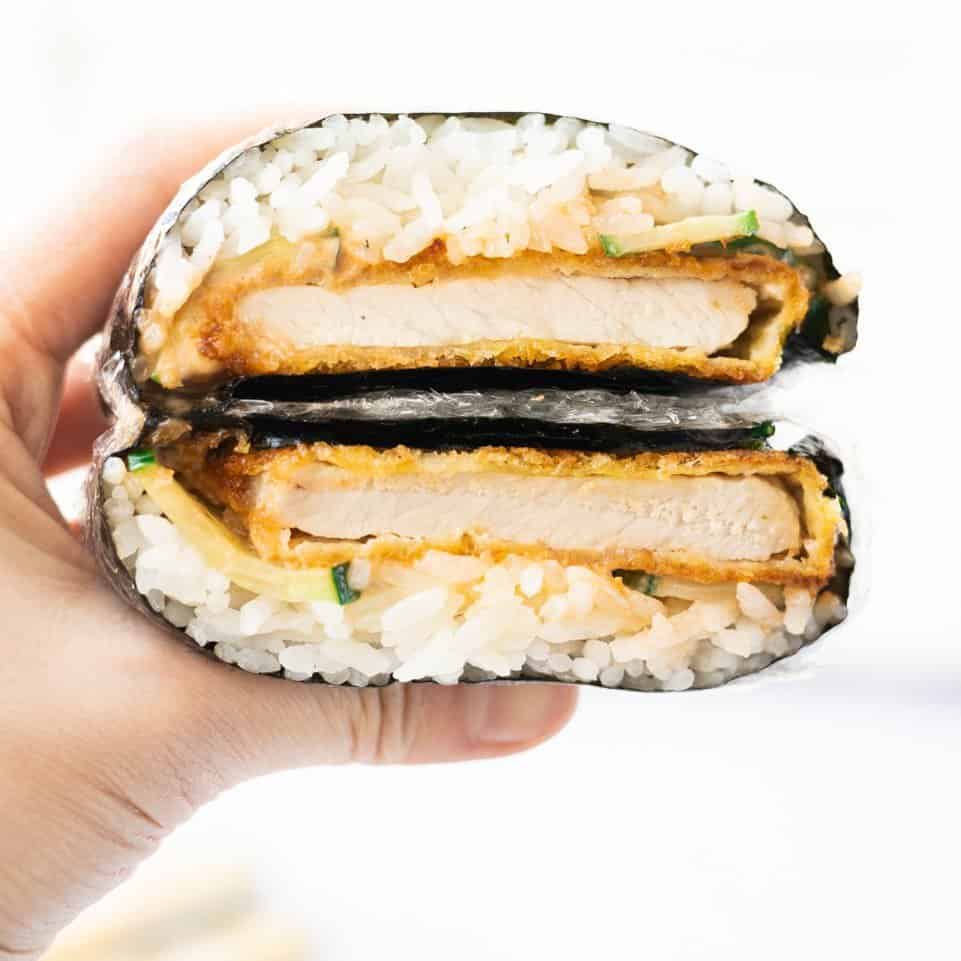
Ingredients & Substitutes
Please scroll down to below recipe card for exact measurements.
- Nori: these are sheets of dry roasted seaweed and you can find it at most Asian grocery stores, select Western grocers or even online.
- Cooked Short Grain Rice (aka sushi rice or Calrose rice): this is the ideal type of rice for this recipe because the grain is short and stickier. Or substitute with medium grain rice as a last resort and avoid using long grain rice.
- Seedless Cucumber: ideally English cucumber or mini Persian cucumbers because they are crunchy, thin-skinned and without seeds.
- Store-bought Tonkatsu Sauce: this is a sweet tangy brown sauce sold at many Asian grocery stores or online.
- Japanese mayo (aka Kewpie Mayo): a very creamy Japanese-style mayonnaise made of egg yolks instead of using whole eggs like in regular mayo. As a last resort, substitute with regular mayo.
- Salt
Pork Katsu
- Pork Loin: or substitute with deboned pork chops or boneless pork shoulder sliced into 3-inch wide x 4-inch long pieces with ½-inch thickness.
- Cornstarch or Potato starch: or substitute with all-purpose flour as a last resort.
- Large Egg
- Japanese Panko Breadcrumbs: these are long and flakier breadcrumbs made of finely processed Japanese milk bread. I advise using any kind imported from Japan or Korea for best texture. Or substitute with regular breadcrumbs as a last resort.
- Neutral oil: like avocado oil, sunflower oil, grapeseed oil, peanut oil, vegetable oil or canola oil with a high smoke point. Avoid olive oil that has a low smoke point.
Note: Most Asian grocery stores will carry most of the Asian specific ingredients or check online stores, like Amazon.
Expert Tips
- Source fresh sliced pork loins from the grocery store to reduce preparation work and time.
- Evenly dredge pork loins, ensuring no bald spots for an overall crispy texture.
- Fry tonkatsu over medium heat and no higher or this will result in undercooked pork with a burnt or overly browned breaded coating.
- Rest fried pork on a wire rack or paper towel lined plate to remove excess oil, which make the crispy pork soggy.
- Use warm freshly cooked rice for best texture! This ensures the rice is moist and sticky so it stays intact when wrapping. If you have cold leftover rice, microwave it for 90 seconds covered.
- Don't over stuff with fillings. Only use the specified amounts or your sandwich will come apart.
- Tightly wrap the cling film around the onigirazu and slice in half with a very sharp knife.
Instructions
Below are step-by-step instructions on how to make pork katsu onigirazu:
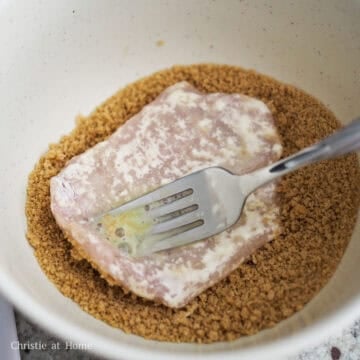
- Pat dry the pork loins with clean paper towel. Then spread cornstarch in a large shallow bowl, beaten eggs into a second bowl and panko breadcrumbs in a third bowl. Evenly dredge each slice of pork into the cornstarch shaking off any excess, then into the beaten eggs and lastly panko breadcrumbs.

- Heat vegetable oil in a large pan on medium heat. Shallow fry the coated pork loins into the hot oil in small batches on both sides until golden brown. Cooked pork has an internal temperature of 145 F with a digital instant read thermometer. Remove and transfer fried pork onto a wire rack or paper towel lined plate to remove excess oil.

- Lay out a large sheet of plastic wrap (about 12 x 15 inches) onto a large cutting board. Then place a sheet of nori rough side up on top of the plastic wrap. Into the center of the nori, add ⅓ cup of warm cooked sushi rice and shape it into a rectangle.
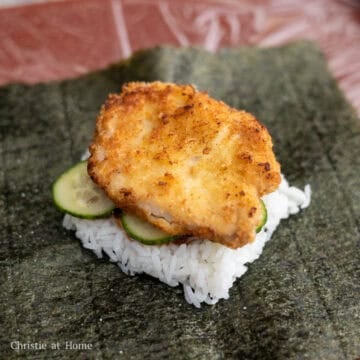
- Evenly sprinkle salt on top of the rice. Squeeze 1 tablespoon tonkatsu sauce and 1 tablespoon Japanese mayo on top of the rice. Then place 6 pieces of thinly sliced cucumbers on top of the sauce, followed by pork katsu.

- Tightly wrap the corners of the nori sheet around the fillings to create a parcel. Then tightly wrap the plastic wrap around the onigirazu.

- Using a sharp knife, cut the onigirazu into half. Repeat the above process to make 5 more onigirazu sandwiches. Enjoy fresh!
Storage
- Pork Katsu Onigirazu is best consumed fresh or within 12 hours because rice is a breeding ground for bacteria.
- Leftovers? If you have leftover onigirazu, you can store them into airtight containers in the fridge for up to 2 days and can be reheated in the microwave for 60-90 seconds until hot. Warning: refrigerated onigirazu doesn't usually taste great after refrigeration because the short grain rice hardens even after reheating.
- Freezer-friendly? I don't recommend freezing onigirazu because the freezer changes the texture of the rice and cucumbers.
Pairing Suggestions
Pork katsu onigirazu serves well with:
- starters like miso soup, Japanese crab corn salad or salad with Japanese ginger salad dressing or korokke.
- seafood dishes like shrimp tempura, panko shrimp or ebi mayo.
- protein dishes like ramen eggs, chicken katsu or tonkatsu, karaage, teriyaki tofu, teriyaki Chicken, or ginger miso salmon.
- rice dishes like tuna onigiri, oyakodon, omurice, or katsudon.
- other noodle dishes like yaki Udon, creamy mushroom udon, or udon carbonara.
FAQ
Onigirazu is usually best made same day. However, you may prepare the fillings like the rice, pork katsu and cucumber slices up to 4 days in advance. Then on the day of serving, reheat the pork katsu and rice in the microwave and assemble the onigirazu as instructed in the recipe.
Onigirazu is eaten at room temperature by hand, like a sandwich.
📖 Recipe
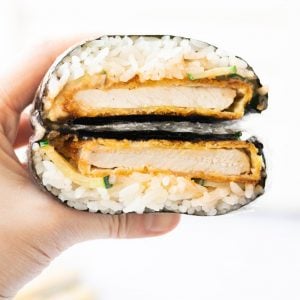
Pork Katsu Onigirazu
Ingredients
- 6 sheets nori
- 2 cups cooked short grain rice
- ½ English cucumber sliced thinly into 36 pieces
- 6 tablespoon tonkatsu sauce store bought
- 6 tablespoon Japanese mayo or regular mayonnaise
- 1.5 teaspoon salt
For the Pork Katsu:
- 6 slices pork loin about 4 x 3 inches and ½-inch thick per slice
- 2 tablespoon cornstarch or potato starch, add more if needed
- 1 large egg beaten
- ½ cup panko breadcrumbs or regular breadcrumbs, add more if needed
- ⅓ cup vegetable oil or any neutral oil
Instructions
- Pat dry the pork loins with clean paper towel. Then spread cornstarch in a large shallow bowl, beaten eggs into a second bowl and panko breadcrumbs in a third bowl. Evenly dredge each slice of pork into the cornstarch shaking off any excess, then into the beaten eggs and lastly panko breadcrumbs.
- Heat vegetable oil in a large pan on medium heat. Shallow fry the coated pork loins into the hot oil in small batches on both sides until golden brown. Cooked pork has an internal temperature of 145 F with a digital instant read thermometer. Remove and transfer fried pork onto a wire rack or paper towel lined plate to remove excess oil.
- Lay out a large sheet of plastic wrap (about 12 x 15 inches) onto a large cutting board. Then place a sheet of nori rough side up on top of the plastic wrap. Into the center of the nori, add ⅓ cup of warm cooked sushi rice and shape it into a rectangle.
- Evenly sprinkle salt on top of the rice. Squeeze 1 tablespoon tonkatsu sauce and 1 tablespoon Japanese mayo on top of the rice. Then place 6 pieces of thinly sliced cucumbers on top of the sauce, followed by pork katsu.
- Tightly wrap the corners of the nori sheet around the fillings to create a parcel. Then tightly wrap the plastic wrap around the onigirazu.
- Using a sharp knife, cut the onigirazu into half. Repeat the above process to make 5 more onigirazu sandwiches. Enjoy fresh!


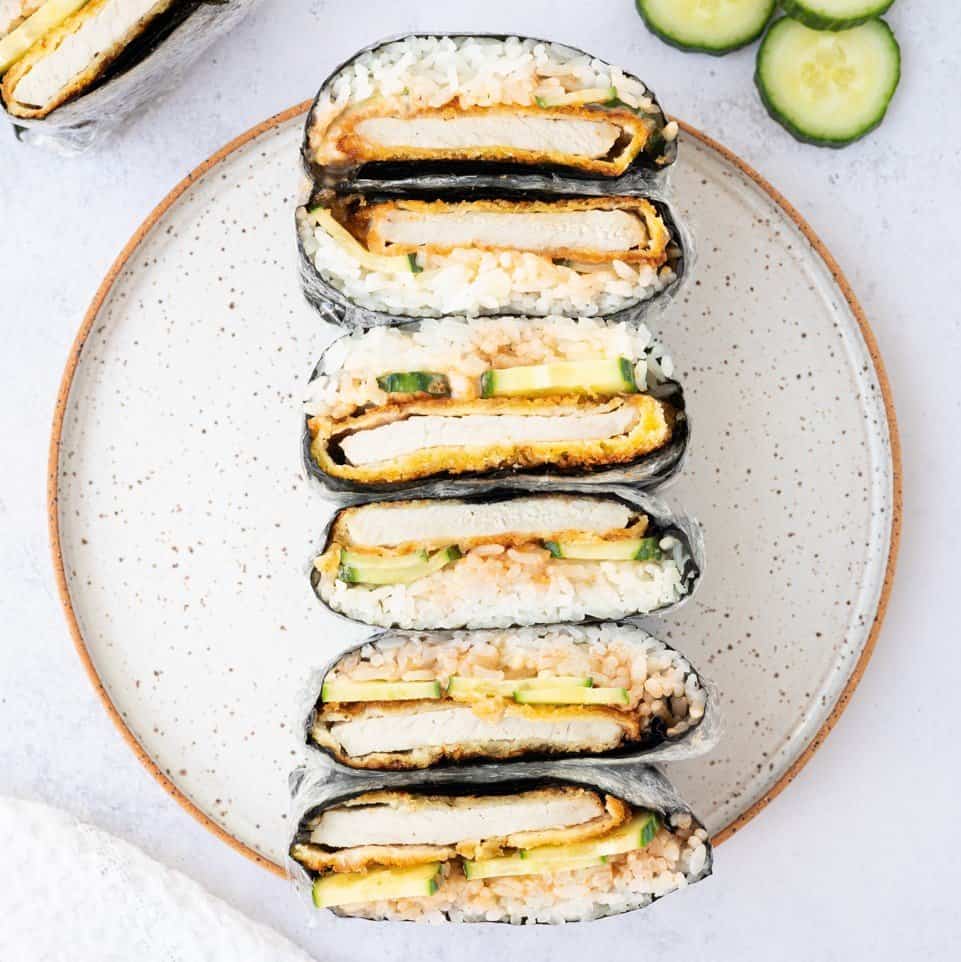

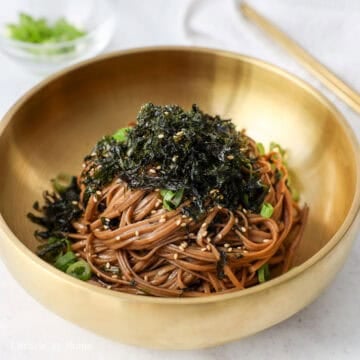


Did you enjoy my recipe?